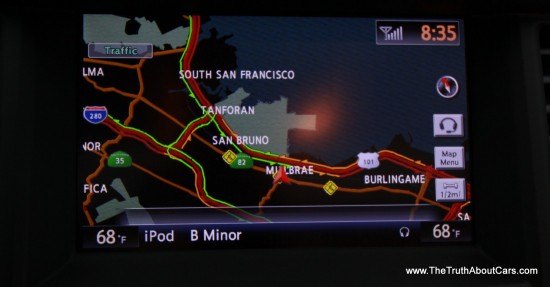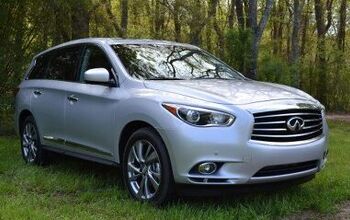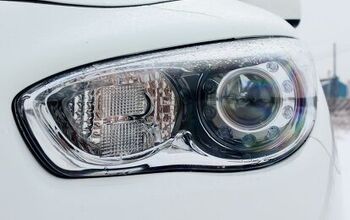Review: 2013 Infiniti JX35 (Video)

So you think you need to carry seven people in comfort with decent economy but you don’t want to buy a minivan? Enter the three-row crossover. Thanks to stronger fuel economy regulations there are plenty of three-row CUVs to choose from, but you want something with a better brand name under 55-large, what does that do to the playing field? You’re left with the Lincoln MKT, Acura MDX, Volvo XC90, Buick Enclave and the newcomer in this phone booth sized segment: the 2013 Infiniti JX35. The new soft-roader Infiniti is already off to a good start coming in third in sales to the Enclave and MDX despite sales starting in April of this year. What’s it like to live with for a week and how does it stack up? Click through the jump to find out.
Before we dive into the JX, let’s look at the competition. The Volvo XC90 arguably started this segment in 2003 by jacking an S80 up a few inches and adding a third row. In 2006 Acura followed their lead by adding a third row to the Accord-based MDX. Buick got in on the party with their minivan-like Enclave in 2008 and Lincoln with their seemingly hearse-themed MKT in 2010. What do these CUVs have in common? They all have six cylinder engines under the hood and they are all front wheel drive vehicles with optional all wheel locomotion. Before Audi fans start flaming me, I left the Q7 out due to its SUV-like design, RWD biased Quattro system, larger price tag, and decidedly SUV-like 5,600lb curb weight.
Exterior
Infiniti’s bulbous styling may not be everyone’s cup of tea, but it is a distinctive island in a sea of me-too crossovers. This new take on Infiniti’s “box fish” style isn’t as striking (or polarizing) as when the M debuted in 2010. On the bright side, now that the design has aged, general opinion in my informal lunch group was overwhelmingly positive. Something I couldn’t say about the 2010 M. Despite heavy parts sharing with the new Pathfinder, the JX is better distinguished than the former generation QX/Armada was and indeed better differentiated than the Chevy Traverse and Buick Enclave. The MKT looks just looks downright peculiar front the front with the new Lincoln grille grafted on and the side profile just reminds me of an old station wagon based hearse from the 1970s. The MDX is quite possibly the best looking Acura available at the moment despite the rather prominent Acura beak on the grille. Meanwhile the XC90 is the only vehicle in this bunch that’s not based on a mass market vehicle or platform. While that does mean there isn’t anything on the road that looks related, the design is only modern when parked by itself. I still have a soft spot for the XC90’s upright grille and sexy Swedish hips, but this is one warhorse that should have been sent to the glue factory 5 years ago.
Interior
The JX35’s cabin is covered in soft-touch plastics, leather and acres of highly polished wood trim, just as you expect from Infiniti. In this segment, if you want an interior that doesn’t share parts with a mass-market brand, you’re again limited to the XC90 as every other design team had access to a corporate parts bin. Keeping this in mind, Nissan/Infiniti’s parts bin is a nicer place to spend time than GM’s button-bank. The new Enclave has a very competitive interior, but some of the parts choices fail to blend while the JX is a sea of harmony. Indeed one might say the Pathfinder borrows Infiniti parts and not the other way around. This top-down parts sharing is good for Pathfinder shoppers, but only time will tell if there is enough differentiation to make Infiniti shoppers happy. The XC90’s interior is still competitive thanks to continual tweaks over the past ten years, but that can’t forgive the lack of even a modest refresh from the Swedes.
As with the Pathfinder, JX seat comfort declines the further right and rearward you go. The front passenger seat lacks the power lumbar adjustment of the driver’s seat. The second row seats are comfortable, but not as padded as the front seats with cushions designed for children or shorter passengers. If third row comfort is critical, go back to looking at that QX56 or Escalade, as with most three-row crossovers the JX’s last row should be reserved for coworkers you hate or your mother-in-law. If you regularly carry passengers and progeny in child seats, the JX shares the sliding middle seat design with the Pathfinder allowing a child seat to stay strapped in while passengers climb into the third row.
Infotainment & Gadgets
The standard 7-inch infotainment screen does everything but navigation. iDevice/USB integration is of course standard as is Bluetooth and a 6-speaker audio system with a single disc CD player and XM radio. Opting for the $4,950 “premium package” gets you Infiniti’s easy to use navigation system with a high-resolution 8-inch touchscreen, a 13-speaker Bose sound system, voice control, and Infiniti’s slick all-around camera system. The system uses four cameras and some trick processing to stitch images together to form an “aerial view” making easy work of tight parking situations.
Should you desire the latest in nannies, Infiniti is happy to oblige with radar cruise control, collision warning and prevention, lane departure warning and prevention and an accelerator pedal that fights back. The accelerator pedal is perhaps the nanny that people find the most fault with, despite crossovers not being “driver’s cars.” The feature can be disabled, but left on it will fight your right foot, forcing the pedal back at you if you’re driving uneconomically, if it thinks you are getting too close to a car, or if it feels like it needs to stop the car NOW. While I dislike the thought of a car that drives for me, honestly at least half the drivers on the road need this pedal stat. Not that I condone distracted driving, but if you feel the need to text and drive, the JX helps you accomplish the feat more safely.
Lincoln’s MKT slots in just behind the Infiniti on the gadget tally thanks to Ford’s bevy of collision avoidance options, inflating seatbelts, and the slow but feature-rich MyLincon Touch system. Meanwhile the Enclave’s new Intellilink touchscreen system is sharp, responsive and has more natural voice commands than SYNC. Better yet, Buick’s system is standard on all Enclave models. The MDX puts on a good fight, but Acura’s tech suffers from old school graphics and a confusing control joystick despite being the only other entry to offer voice commands for your USB/iDevice music player. The XC90 has finally been updated to offer the basic infotainment features you would expect from a luxury vehicle including Bluetooth, USB/iDevice integration and blind spot notification, but that’s where the goodies stop. The XC90 still uses Volvo’s “olde” pop-up navigation system from 1999 and cannot be had with radar cruise control, pedestrian and obstacle detection, and a myriad of other features found in the smaller XC60.
Drivetrain
The JX shares its 3.5L VQ-series V6 with the Pathfinder and everything from the Altima to the Quest. In the JX, the engine puts out 265HP at 6,400RPM and 248lb-ft at 4,400RPM, a mild bump over the Pathfinder but notably lower than the Maxima’s 290HP/261lb-ft tune. Like the Pathfinder, the JX sends power either the front wheels or to all four via a Haldex-style AWD system, but this is where the similarities end. While the Pathfinder uses an all-new heavy-duty continuously variable transmission (CVT) with a chain, the JX35 still uses the second-generation Xtronic CVT shared with the Muran0.
When it comes to towing, transmissions choices are important, but so are chassis and suspension design. In the case of the JX, we can logically infer the lack of the Pathfinder’s heavy-duty CVT is the reason for the reduced 3,500lb towing capacity. Meanwhile the Enclave and MKT will haul 4,500lbs while the XC90 and MDX tie at 5,000lbs. Of course, I seem to be the only one who ever tows with a mid-size SUV so this is probably the least important part of this review. That being said, the XC90 despite being down on power would be my towing partner of choice because it has an available load leveling rear suspension.
Drive
Out on the road the JX35 is as nimble as a tall 4,500lb vehicle can be. While the handling crown in this segment still goes to the MDX, thanks to Acura’s SH-AWD system, the JX can handle winding roads faster than your third row passengers will tolerate. The JX’s steering is moderately quick, fairly firm and as numb as any of the other luxury crossovers. Should you be on your own after the school run, the JX’s well sorted suspension will soak up the ruts should you decide that gravel road shortcut you like.
Front wheel drive JX models suffer from mild torque steer from a stand still but once underway the pulling stops and the JX settles down. Opting for the AWD system quells the torque steer daemon and is a further differentiator from the Pathfinder cousin. The Pathfinder’s AWD system allows the driver to lock the system in FWD mode for better economy, lock the center coupling for better grip, or allow the system to decide when to send power to the rear. Instead the AWD system in the JX always operates in Auto mode, which is just as well since I suspect no luxury SUV or CUV shopper will ever notice the difference.
The biggest difference between the other luxury CUVs and the JX35 is the transmission. The effective ratio spread on the JX35’s transmission isn’t as broad as the 6-speed units used in the competition and seemed to be skewed to the higher end of the ratio spectrum for fuel economy. This is most obvious when you look at the JX35’s relatively slow 3.7-second 0-30 time, but thanks to the infinite ratios the JX catches up to the rest of the pack crossing 60MPH in 7 seconds even. Despite the 0-30 sloth, my real-world fuel economy tests seem to be kind to CVT equipped vehicles with the JX besting its 20MPG combined EPA score by 7/10ths of an MPG over a week. Meanwhile the other CUVs averaged 1-2MPG below their combined figures for me. So many publications spout their MPG figures as gospel, but as with 0-60 times, observed fuel economy is only as good as the driver, driving style and commute.
The JX represents an interesting move for the brand I like to think of as “the Japanese BMW.” But putting practicality and economy before performance they have created a most un-Infiniti crossover. The combination of a nearly perfect interior, smooth CVT and 32% better fuel economy than Infiniti’s QX SUV make a compelling argument for the JX35. While the Enclave plays to a slightly different demographic, MDX shoppers would do well to put the JX on their short list as it is quite possibly the best three-row luxury crossover in America.
Infiniti provided the vehicle, insurance and one tank of gas for this review.
Specifications as tested
0-30: 3.7 Seconds
0-60: 7 Seconds
1/4 Mile: 16.4 @ 90 MPH
Average Fuel Economy: 20.7 MPG over 765 miles

More by Alex L. Dykes
Latest Car Reviews
Read moreLatest Product Reviews
Read moreRecent Comments
- MaintenanceCosts E34 535i may be, for my money, the most desirable BMW ever built. (It's either it or the E34 M5.) Skeptical of these mods but they might be worth undoing.
- Arthur Dailey What a load of cow patties from fat cat politicians, swilling at the trough of their rich backers. Business is all for `free markets` when it benefits them. But are very quick to hold their hands out for government tax credits, tax breaks or government contracts. And business executives are unwilling to limit their power over their workers. Business executives are trained to `divide and conquer` by pitting workers against each other for raises or promotions. As for the fat cat politicians what about legislating a living wage, so workers don't have to worry about holding down multiple jobs or begging for raises? And what about actually criminally charging those who hire people who are not legally illegible to work? Remember that it is business interests who regularly lobby for greater immigration. If you are a good and fair employer, your workers will never feel the need to speak to a union. And if you are not a good employer, then hopefully 'you get the union that you deserve'.
- 28-Cars-Later Finally, something possibly maybe worth buying.
- EBFlex The simple fact is very small and cheap ICE vehicles have a range thats longer than all EVs. That is the bar that needs met. And EVs cannot meet that.Of course range matters. But that's one element of many that make EVs completely ineffective at replacing ICE vehicles.
- Wolfwagen I like the exterior mods short of the satellite dish. Put a normal interior in it and they could have sold it as some sci-fi movie trim





























































Comments
Join the conversation
recently drove most everything in this segment (and more) in the 40k-80k price range to replace an '09 MDX that replaced an '04 Pilot. I prefer cars and drive a Boxster S, but this is for my wife. Wanted to like the Infinity, but too much like driving a mini van with poor accelleration feel. Too pricy for what I wanted. The bigger Infinity was much too large - might as well buy a Yukon - and others didn't drive very sharp at all. Wound up buying an '13 MDX Advance with all the options - and was surprised at the deal made through negotiations. Nice accelleration and handling for for the segment. Had the 3 rows for kids and AWD for peace of mind for my wife. Still surprised, but really didn't like the others with 60k pricetag.
I like the interior cluster and gauges, and the polished wood. And I like that it'll probably be reliable. But I could never get over the hideous appearance of this beast, and every time I saw the back, I'd think, "Needs a brow lift."